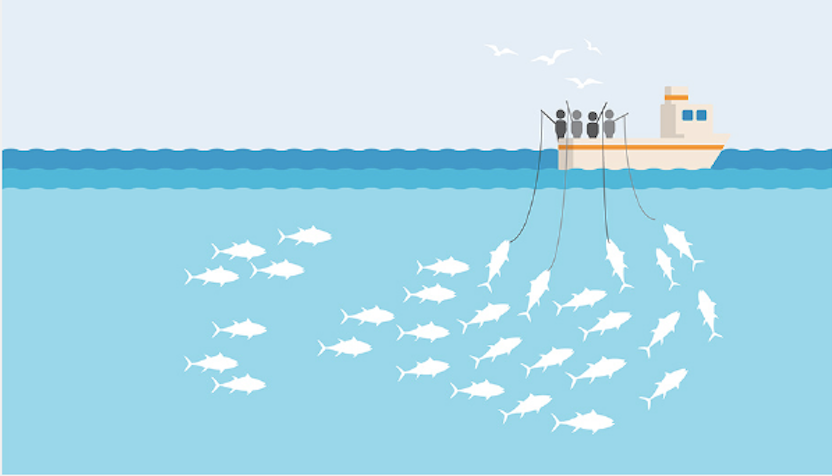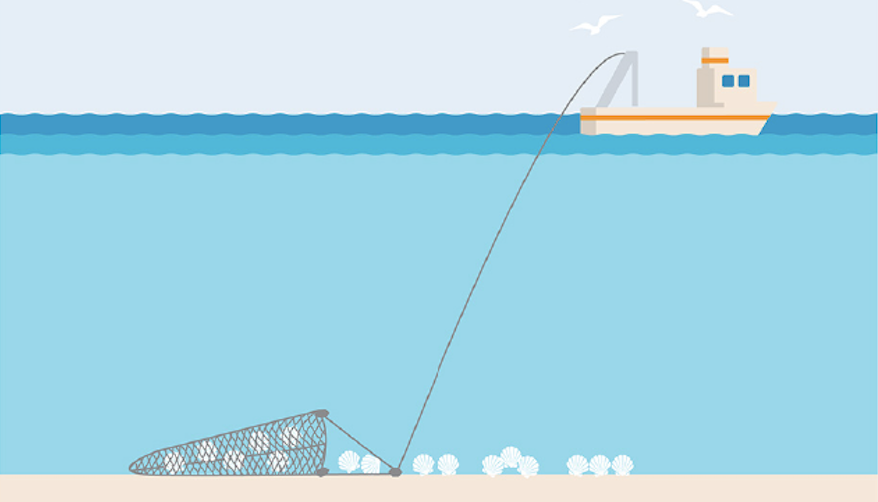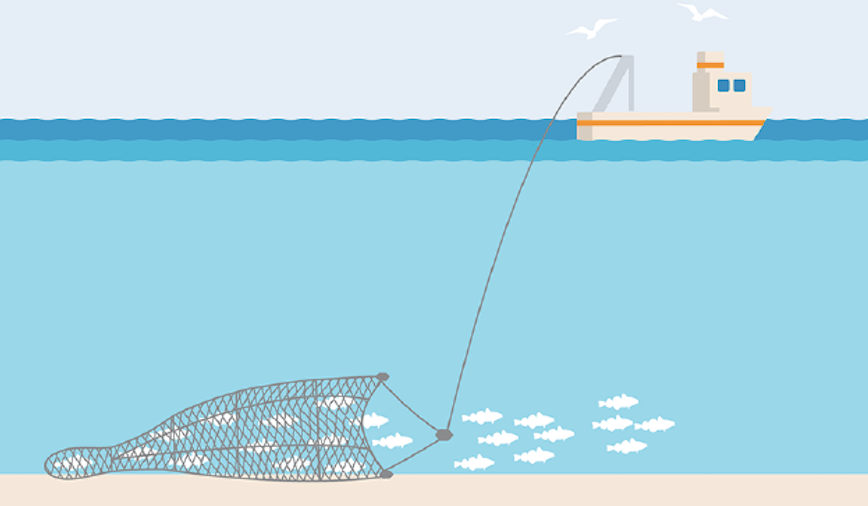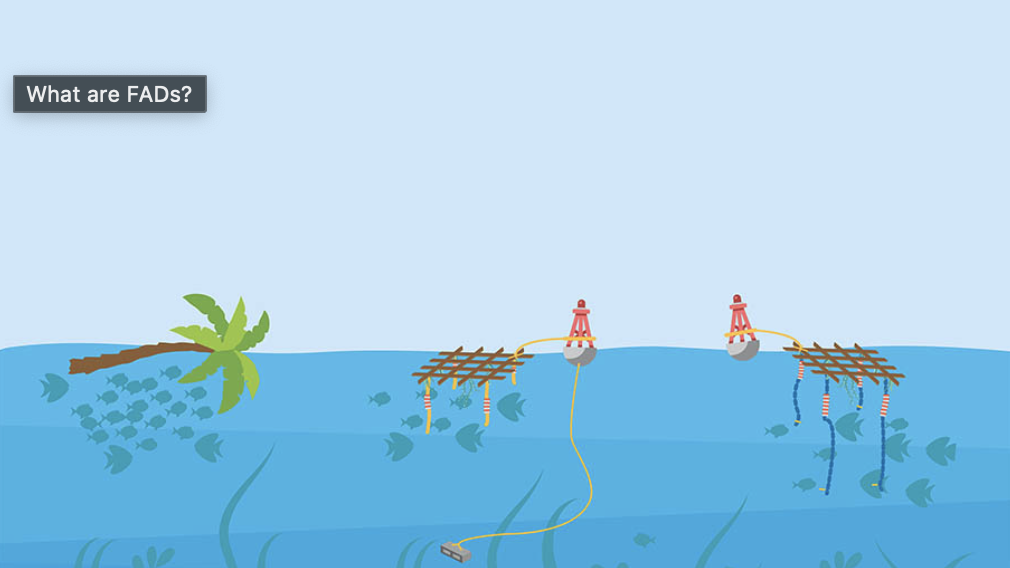A summary of the most widely used fishing methods in the world courtesy of the Marine Stewardship Council (MSC) under CC by author Hannah Ritchie.
What methods do we use to fish?
Say the word “fishing” and very different images come to mind. Some of us might imagine a lone fisherman with a wooden fishing pole. Others will imagine a net 100 meters wide dragged across the seabed by an industrial ship.
There are a variety of ways to fish. These matter because they depend on what fish we want to catch; affect the amount of fish we can catch (and ultimately the amount of fish we have to eat and the income fishermen earn); and what are the ecological impacts.
Debates about fishing can be full of jargon. If you’re not familiar with this research, it can be difficult to understand exactly what each method looks like and what it entails. To make it easier, I’ve created the following visualization, which presents an overview of the most common fishing methods. This is based on summary images from the Marine Stewardship Council.
This equipment is used all over the world, but there are some general patterns where certain methods are more widely used. Pole-and-line, longline, and gillnet methods are more common in low-income countries where much of the fishing activity is subsistence or small-scale. Purse and trawl methods are more common in industrial fishing practices; they tend to catch more fish per unit of effort. But the downside is that they tend to have larger negative impacts, with more bycatch (catch of fish that are not the target species) and, in some cases, damage to the seabed.
Diving
In some commercial fisheries such as sea urchin, giant clam (in English, geoduck, and several other names in Spanish depending on the locality), and sea cucumber, the species are extracted by divers.
Pole and line

It is used to fish for Tuna and other large pelagic (midwater) species, one fish at a time.
When a target school of fish is located, water is sprayed from the rear of the fishing boat and small baitfish (e.g. sardines) are scattered over the surface of the water, creating the illusion of an active school of prey fish.
This process, known as chumming, sends the target fish into a feeding frenzy during which it will chew on anything in sight. Anglers line up along the back of the boat, each carrying a wooden or fiberglass hand pole with a short line and a barbless hook. Once a fish is hooked, it is cast up and over the angler’s head and onto the deck.
Longlines

As the name suggests, longline fisheries trawl a long line, or mainline, behind a vessel.
Baited hooks are attached to the nets at intervals to attract target species. Longlines can be set for pelagic (midwater) or demersal (bottom) fishing, depending on the target species.
Without careful management, longline fisheries can have unwanted interactions with non-target fish, seabirds, and other marine life.
Gillnets

A gillnet is a wall or curtain of netting that hangs in the water. The term covers various forms, including stationary gillnets and trammel nets.
Gillnets generally have a low environmental impact with minimal interaction with the seabed. The size of the fish caught can be determined by the mesh size, which helps to avoid catching juvenile fish.
While particular species of fish may be targeted by area, gillnets carry the risk of bycatch (accidental capture of unwanted species) and interaction with other marine animals.
Purse seine

Purse seines are used in the open ocean to attack dense schools of pelagic (midwater) fish of a single species, such as tuna and mackerel.
A vertical net “curtain” is used to encircle the school of fish, the bottom of which draws together to enclose the fish, as if the strings of a drawstring bag were tightened.
Open water purse seine fishing is generally considered an efficient form of fishing. It has no contact with the seabed and may have low levels of bycatch (accidental capture of unwanted species).
Purse seines can also be used to catch fish that congregate around fish aggregating devices. This method of fishing can result in higher levels of bycatch.
Pots and traps

Stationary traps or pots, usually made of wood, wire mesh, or plastic, are used to catch crustaceans such as lobsters and crabs. Although the size and shape of the traps can vary, they all feature a cone-shaped entrance tunnel through which a crab or lobster is lured with bait but unable to escape.
The traps are deployed on the seabed for about 24 hours before being brought aboard a boat for harvesting and re-baiting. Although they can be set individually, they are more commonly set in chains (fleets) with several traps attached to a long rope.
Dredges

Dredges are rigid structures that are towed across the seabed to harvest bivalves such as scallops, oysters, and clams.
The design of dredges varies depending on the species they are targeting, but many consist of a triangular frame. A bar (with or without teeth) at the front of this frame dislodges shellfish as they drag over the sediment and into a metal collecting basket. By contrast, hydraulic dredges use water jets to disturb the seabed and dislodge shellfish. The use of specific mesh sizes and escape panels prevent any undersized or non-target species from becoming trapped in the basket.
The environmental impact of dredging varies significantly depending on the type of sediment on the seabed and the habitat it supports. As such, there is often strict regulation on the types of dredges allowed and how often they can operate in an area.
Pelagic or midwater trawls

Pelagic or mid-water trawls have a cone-shaped body and a closed “flake” that holds your catch.
Pelagic trawls are generally much larger than bottom trawls and can be towed by one or two boats (pair trawling). They are designed for surface and mid-water fish such as herring, hoki and mackerel. Acoustic technology is used to locate the position and depth of the target fish and the trajectory of the vessel(s) and trawls are adjusted accordingly.
Midwater trawls have no contact with the seabed. They are occasionally associated with the incidental capture of non-target species (bycatch).
Demersal or bottom trawl

Trawling is common all over the world due to its efficiency in catching large numbers of fish.
Demersal or bottom trawling covers several types of gear, all of which use a cone-shaped net with a closed end (codend) that holds the catch. These nets are towed by one or two boats and are designed to catch fish that live deep or on the bottom of the sea.
While demersal trawling often interacts with the seabed, careful management and modifications to fishing operations can reduce environmental impacts and increase sustainability.
Fish Aggregating Devices (FAD)

Fish aggregating devices (FADs) are usually floating man-made wooden structures with hanging nets to attract fish. These rafts can be free-floating (known as drifting FADs or dDCPs) or anchored to the seabed (known as anchored FADs or aDCPs).
Some tuna fisheries also target natural structures or objects, including free-floating logs (tree trunks) and large marine animals, such as whale sharks, around which the fish congregate. This is known as ‘nature-associated’ or ‘object-associated’ fishing.
Source:
Ritchie H. & Roser M. (2021, Octubre) Fishing and Overfishing, Our world in Data (first published). URL: https://ourworldindata.org/fish-and-overfishing#total-seafood-production-by-country
In appreciation to the authors Ray Hilborn, Michael Melnychuk, Max Mossler y Daniel Hively from RAM Legacy Stock Assessment Database for the provision of the data and the feedback about the project.

